This document summarizes key points about deadlocks from Chapter 7 of the textbook "Operating System Concepts". It discusses the deadlock problem, system model, characterization of deadlocks, and various methods for handling deadlocks including prevention, avoidance, detection and recovery. Specific techniques are explained like the resource allocation graph, banker's algorithm and safety algorithm. The document contains diagrams and examples to illustrate deadlock situations and different states like safe, unsafe and deadlocked states.
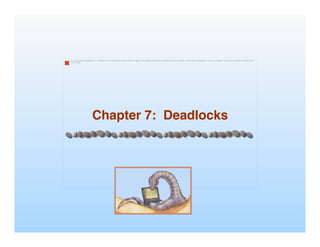
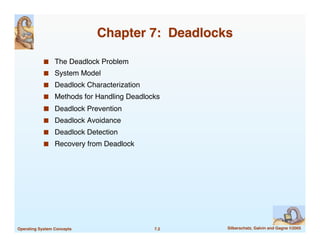
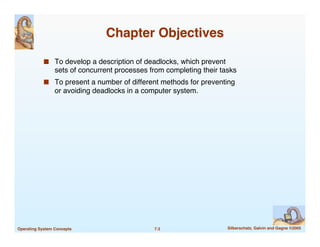

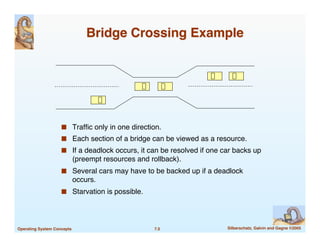























![7.29! Silberschatz, Galvin and Gagne ©2005
!
Operating System Concepts!
Data Structures for the Banker’s Algorithm!
■ Available: Vector of length m. If available [j] = k, there are k
instances of resource type Rj available."
■ Max: n x m matrix. If Max [i,j] = k, then process Pi may
request at most k instances of resource type Rj."
■ Allocation: n x m matrix. If Allocation[i,j] = k then Pi is
currently allocated k instances of Rj."
■ Need: n x m matrix. If Need[i,j] = k, then Pi may need k
more instances of Rj to complete its task."
Need [i,j] = Max[i,j] – Allocation [i,j]."
Let n = number of processes, and m = number of resources types. "](https://image.slidesharecdn.com/ch07-221209111402-3b4bb789/85/ch07-pdf-29-320.jpg)
![7.30! Silberschatz, Galvin and Gagne ©2005
!
Operating System Concepts!
Safety Algorithm
!
1. "Let Work and Finish be vectors of length m and n,
respectively. Initialize:"
Work = Available!
Finish [i] = false for i - 1,3, …, n."
2. "Find and i such that both: "
(a) Finish [i] = false"
(b) Needi ≤ Work!
If no such i exists, go to step 4."
3. "Work = Work + Allocationi
Finish[i] = true
go to step 2."
4. "If Finish [i] == true for all i, then the system is in a safe
state."](https://image.slidesharecdn.com/ch07-221209111402-3b4bb789/85/ch07-pdf-30-320.jpg)
![7.31! Silberschatz, Galvin and Gagne ©2005
!
Operating System Concepts!
Resource-Request Algorithm for Process Pi
!
Request = request vector for process Pi. If Requesti [j] = k then
process Pi wants k instances of resource type Rj."
1."If Requesti ≤ Needi go to step 2. Otherwise, raise error
condition, since process has exceeded its maximum claim."
2."If Requesti ≤ Available, go to step 3. Otherwise Pi must
wait, since resources are not available."
3."Pretend to allocate requested resources to Pi by modifying
the state as follows:"
" "Available = Available = Requesti;!
" "Allocationi = Allocationi + Requesti;"
" "Needi = Needi – Requesti;!
● If safe ⇒ the resources are allocated to Pi. !
● If unsafe ⇒ Pi must wait, and the old resource-allocation
state is restored!](https://image.slidesharecdn.com/ch07-221209111402-3b4bb789/85/ch07-pdf-31-320.jpg)



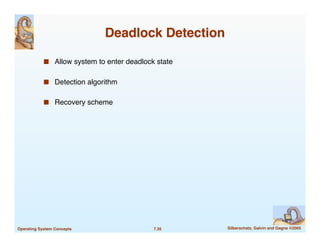


![7.38! Silberschatz, Galvin and Gagne ©2005
!
Operating System Concepts!
Several Instances of a Resource Type
!
■ Available: A vector of length m indicates the number of
available resources of each type.
"
■ Allocation: An n x m matrix defines the number of
resources of each type currently allocated to each process.
"
■ Request: An n x m matrix indicates the current request of
each process. If Request [ij] = k, then process Pi is
requesting k more instances of resource type. Rj."](https://image.slidesharecdn.com/ch07-221209111402-3b4bb789/85/ch07-pdf-38-320.jpg)
![7.39! Silberschatz, Galvin and Gagne ©2005
!
Operating System Concepts!
Detection Algorithm
!
1. "Let Work and Finish be vectors of length m and n, respectively
Initialize:"
(a) Work = Available"
(b) "For i = 1,2, …, n, if Allocationi ≠ 0, then
Finish[i] = false;otherwise, Finish[i] = true."
2. "Find an index i such that both:"
(a) "Finish[i] == false"
(b) "Requesti ≤ Work
"
If no such i exists, go to step 4. "](https://image.slidesharecdn.com/ch07-221209111402-3b4bb789/85/ch07-pdf-39-320.jpg)
![7.40! Silberschatz, Galvin and Gagne ©2005
!
Operating System Concepts!
Detection Algorithm (Cont.)
!
3. "Work = Work + Allocationi
Finish[i] = true
go to step 2.
"
4. "If Finish[i] == false, for some i, 1 ≤ i ≤ n, then the system is in
deadlock state. Moreover, if Finish[i] == false, then Pi is
deadlocked."
""
Algorithm requires an order of O(m x n2) operations to detect whether the
system is in deadlocked state. "
"](https://image.slidesharecdn.com/ch07-221209111402-3b4bb789/85/ch07-pdf-40-320.jpg)
![7.41! Silberschatz, Galvin and Gagne ©2005
!
Operating System Concepts!
Example of Detection Algorithm
!
■ Five processes P0 through P4; three resource types
A (7 instances), B (2 instances), and C (6 instances)."
■ Snapshot at time T0:"
" " "Allocation !Request !Available!
" " "A B C !A B C !A B C!
" "P0 "0 1 0 "0 0 0 "0 0 0"
" "P1 "2 0 0 "2 0 2"
" "P2 "3 0 3 "0 0 0 "
" "P3 "2 1 1 "1 0 0 "
" "P4 "0 0 2 "0 0 2"
■ Sequence <P0, P2, P3, P1, P4> will result in Finish[i] = true for all i. "
"](https://image.slidesharecdn.com/ch07-221209111402-3b4bb789/85/ch07-pdf-41-320.jpg)




